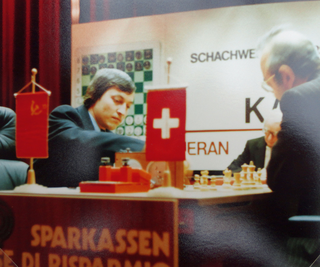The Latvian Gambit is a chess opening characterised by the moves:
Nolot is a chess test suite with 11 very difficult positions from real games. They were compiled by Pierre Nolot for the French chess magazine Gambisco and posted on the rec.games.chess Usenet group in 1994. Some of these positions were particularly hard to solve for chess engines at the time.
In chess, the bishop and knight checkmate is the checkmate of a lone king by an opposing king, bishop, and knight. With the stronger side to move, checkmate can be forced in at most thirty-three moves from almost any starting position. Although this is classified as one of the four basic checkmates, it occurs in practice only approximately once in every 6,000 games.

Edmar John Mednis was a Latvian-American chess player and writer of Latvian origin. He was awarded the title of Grandmaster by FIDE in 1980.

The World Chess Championship 2010 match pitted the defending world champion, Viswanathan Anand, against challenger Veselin Topalov, for the title of World Chess Champion. The match took place in Sofia, Bulgaria from 24 April to 13 May 2010, with a prize fund of 2 million euros. Anand won the final game to win the match 6½–5½ and retain the title.

The World Chess Championship 1886 was the first official World Chess Championship match contested by Wilhelm Steinitz and Johannes Zukertort. The match took place in the United States from 11 January to 29 March, the first five games being played in New York City, the next four being played in St. Louis and the final eleven in New Orleans. The winner was the first player to achieve ten wins. Wilhelm Steinitz won the match 10–5, winning his tenth game in the twentieth game of the match. There were five draws.

The World Chess Championship 1889 was the second official World Chess Championship, and was between Wilhelm Steinitz and Mikhail Chigorin. It took place in Havana, Cuba. Steinitz defended his world title, and was the first of the two players to reach 10½. He won the match 10½-6½.

A World Chess Championship was played between challenger Max Euwe and title-holder Alexander Alekhine in various cities and towns in the Netherlands from 3 October to 16 December 1935. Euwe was the winner by overcoming a three-point deficit as late as the ninth game.

The 1978 World Chess Championship was played between Anatoly Karpov and Viktor Korchnoi in Baguio, Philippines, from July 18 to October 18, 1978. Karpov won, thereby retaining the title.

The 1981 World Chess Championship was played between Anatoly Karpov and Viktor Korchnoi in Merano, Italy from October 1 to November 19, 1981. Karpov won with six wins against two, with 10 draws. The two players had already played against each other in the World Chess Championship match 1978 in the Philippines, when Karpov also won.

The World Chess Championship 2014 was a match between the world champion Magnus Carlsen and challenger Viswanathan Anand, to determine the World Chess Champion. It was held from 7 to 25 November 2014, under the auspices of the World Chess Federation (FIDE) in Sochi, Russia.
The 1992 Fischer–Spassky match between former world chess champions Bobby Fischer and Boris Spassky was billed as a World Chess Championship, though it was an unofficial rematch of their 1972 World Championship match. Fischer won 10–5, with 15 draws.

The World Chess Championship 2016 was a chess match between the reigning world champion Magnus Carlsen and the challenger Sergey Karjakin to determine the World Chess Champion. Carlsen had been world champion since 2013, while Karjakin qualified as challenger by winning the 2016 Candidates Tournament. The best-of-12 match, organized by FIDE and its commercial partner Agon, was played in New York City between 10 and 30 November 2016.

The World Chess Championship 2018 was a match between the reigning world champion since 2013, Magnus Carlsen, and the challenger Fabiano Caruana to determine the World Chess Champion. The 12-game match, organised by FIDE and its commercial partner Agon, was played at The College in Holborn, London, between 9 and 28 November 2018. The games were broadcast on worldchess.com and by NRK.
The 14th season of the Top Chess Engine Championship took place between 17 November 2018 and 24 February 2019. Stockfish was the defending champion, having defeated Komodo in the previous season's superfinal.
The 15th season of the Top Chess Engine Championship began on the 6 March 2019 and ended on 12 May 2019.
The Berlin Defence is a chess opening that begins with the moves:
The 17th season of the Top Chess Engine Championship began on 2 January 2020 and ended on 22 April 2020. TCEC Season 16 3rd-place finisher Leela Chess Zero won the championship, defeating the defending champion Stockfish 52.5-47.5 in the superfinal.
The 19th season of the Top Chess Engine Championship began on 6 August 2020 and ended on 16 October 2020. The season 19 superfinal was a rematch between Stockfish and Leela Chess Zero, the same two engines that had contested the superfinal in the previous two seasons. Stockfish, the defending champion, won by 9 games.
The 20th season of the Top Chess Engine Championship began on 1 December 2020 and ended on 1 February 2021. The defending champion was Stockfish, which defeated Leela Chess Zero in the previous season's superfinal. The season 20 superfinal was a rematch between the same two engines. Stockfish once again came out ahead, winning by 6 games.











